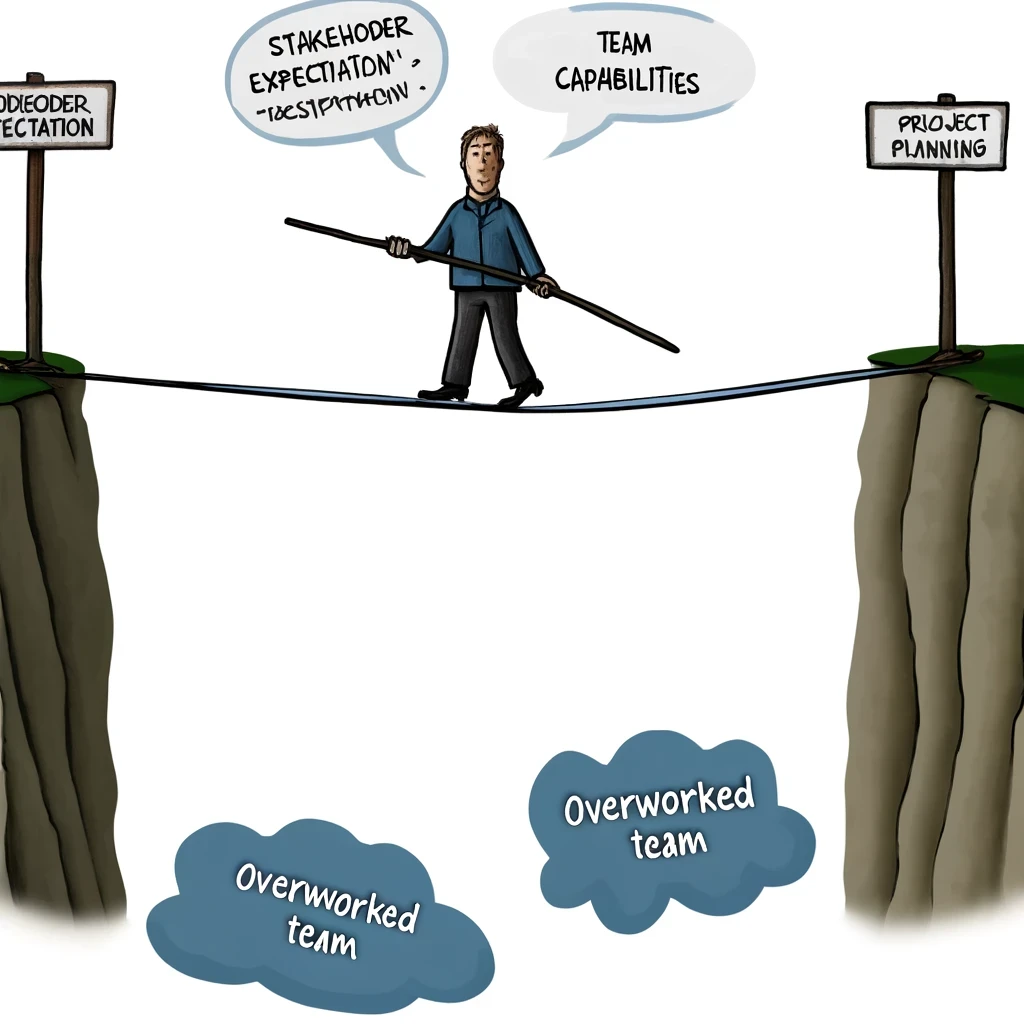Key Challenges for Product Owners in Project Management

Navigating the Rapids: Common Challenges for Product Owners in Project Management
Product Owners are akin to the captains of river rafts navigating through the treacherous rapids of project management. Just as a river captain must be vigilant to avoid rocks and whirlpools, Product Owners face a multitude of challenges that can threaten the smooth flow of their projects.
1. Balancing Stakeholder Expectations and Team Capabilities
One of the most daunting tasks for Product Owners is managing the delicate balance between the expectations of stakeholders and the realistic capabilities of their teams. This balancing act is akin to walking a tightrope over a river, where falling to one side might please the stakeholders but overburden the team, and tipping to the other could keep the team comfortable but disappoint the stakeholders.
Consider a scenario where stakeholders demand a feature-rich product in a remarkably short timeframe. The Product Owner must navigate these demands while ensuring the team is not pushed to burnout. Failure to manage this balance can lead to a subpar product or a demoralized team, akin to a raft capsizing due to uneven weight distribution.
Effective Product Owners regularly engage with both stakeholders and team members, gathering input and setting realistic expectations. This ongoing dialogue helps maintain balance, ensuring that the project progresses smoothly like a well-navigated raft.
Additional Perspective from a Startup Environment
In a startup setting, the challenge of balancing stakeholder expectations with team capabilities becomes even more critical due to typically tighter budgets and resources. For Product Owners in startups, the act of balancing is not just about meeting deadlines but also aligning the product’s development with both client demands and broader market needs without exceeding the available resources.
Imagine a startup working on an innovative health tech app. The market research indicates a strong demand for certain advanced features, and a key investor pushes for these to be included quickly to capitalize on market trends. However, the startup’s development team is small and already stretched thin. The Product Owner must weigh these market opportunities against the realistic capabilities and costs of their team, ensuring that the startup does not overcommit financially or operationally.

For startups, where every resource counts, Product Owners play a crucial role in steering the project through these tight constraints. They must foster an environment where the team feels supported yet challenged, and where the product evolves in a way that is both ambitious and sustainable. Maintaining this balance helps safeguard the startup’s future, much like a carefully balanced raft stays upright in turbulent waters.

2. Prioritization of Tasks
Prioritization is the compass that guides the Product Owner through the project landscape. With an array of tasks varying in importance and urgency, knowing which ones to tackle first can be the difference between a successful project and a failed one.
Imagine a software development project where the team must choose between developing a new feature requested by a significant client or fixing a critical bug affecting all users. The Product Owner must decide which task takes precedence to maximize impact and customer satisfaction, similar to choosing the safest path through rapids.
Skilled Product Owners use tools like the MoSCoW method (Must have, Should have, Could have, Won’t have) to categorize and prioritize tasks effectively. This systematic approach ensures that critical tasks are completed at the right time, keeping the project on track.
Agile Methodology Emphasis
Prioritization is not just a task—it is a core activity in Agile project management. Agile methodologies prioritize quick deployment of functional products that deliver immediate business value. This approach aligns with the concept of creating a Minimum Viable Product (MVP), which emphasizes the importance of rapid releases to test assumptions and gather user feedback efficiently.
Suppose a Product Owner is managing a project to develop a new mobile application. By prioritizing the development of an MVP, which includes only the essential features that solve the primary problem for users, the team can launch a basic but functional version of the app quickly. This allows them to gather user feedback early in the process and iterate accordingly, ensuring that further development efforts are aligned with actual user needs and market demand.
Through the strategic prioritization of features for the MVP, Product Owners ensure that they focus on the most critical aspects of the product that offer the highest return on investment. This disciplined focus helps teams avoid getting sidetracked by less important features, optimizing resources and accelerating time to market. This is especially crucial in dynamic markets where speed and adaptability can significantly influence a project’s success.
This focus on delivering an MVP not only provides clarity and direction but also sets the stage for vigilant management of scope creep, ensuring that the project remains agile and adaptable as new challenges and opportunities arise.
3. Managing Scope Creep
Scope creep is the uncontrolled expansion of project boundaries and is often a silent killer of well-planned projects. For a Product Owner, managing scope creep is like preventing water from flooding a raft. If left unchecked, it can sink the project under the weight of added features and extended deadlines.
A project initially set to revamp a website’s homepage might gradually expand to include additional pages or functionality not originally planned. This expansion can strain resources and timelines, diverting focus from the original goals.
To combat scope creep, successful Product Owners establish clear project boundaries and communicate these limits to all team members and stakeholders. Regular check-ins and updates can also help catch potential scope expansions early before they become unmanageable.
4. Effective Communication
Communication is the lifeblood of any project. Poor communication can lead to misunderstandings, misaligned goals, and project delays, much like how poor signaling in a raft can lead to navigation errors.
If a Product Owner fails to clearly articulate the vision or updates of the project, team members might work towards different objectives, leading to wasted efforts and frustrations. Effective communication ensures that everyone is rowing in the same direction.
Product Owners can enhance communication by utilizing tools such as regular stand-up meetings, clear documentation, and open communication channels. This ensures that every team member is informed and engaged, propelling the project forward like a strong and coordinated crew.
Enhancing Facilitation Skills
Alongside maintaining open lines of communication, Product Owners must also enhance their facilitation skills. This involves effectively leading discussions, resolving conflicts, and ensuring that all team members are aligned with the project goals. A useful tool in achieving this is employing a product model, particularly the AS-IS model, which helps in visualizing the current state of the product and identifying necessary changes.
In a project aimed at upgrading an existing software system, the Product Owner can utilize the AS-IS model to illustrate the current functionalities and limitations of the system to the team. This model serves as a concrete reference point that fosters understanding and focuses discussion on critical areas that require innovation or improvement to meet project goals.
By improving their facilitation skills and using models like AS-IS as central tools in discussions, Product Owners can more effectively guide their teams. This approach not only enhances communication but also ensures that all team members are on the same page, working cohesively towards the necessary transformations that will fulfill the project’s needs and drive success.
Navigating the project management rapids requires skill, foresight, and perseverance. By mastering these common challenges, Product Owners ensure that their projects not only survive the rough waters but also reach their destinations successfully and efficiently. This journey, while fraught with obstacles, is rich with opportunities for growth and achievement, making the role of the Product Owner both vital and rewarding.
Takeaways
- Balancing Stakeholder Expectations with Team Capabilities: Product Owners must carefully manage the expectations of stakeholders while considering the real capabilities and constraints of their team.
- Prioritization is Key in Agile Methodologies: Effective prioritization allows Product Owners to focus on delivering a Minimum Viable Product (MVP) that provides real business value quickly.
- Managing Scope Creep Vigilantly: Product Owners need to actively guard against scope creep to ensure the project remains on track. Clear project boundaries should be established and communicated to all stakeholders to prevent unplanned expansions that can derail the project.
- Enhancing Communication and Facilitation Skills: Strong communication skills are vital for Product Owners. They need to effectively communicate project goals and updates to keep everyone aligned. Additionally, enhancing facilitation skills can help in managing team interactions and resolving conflicts efficiently.
- Using Models like AS-IS for Effective Communication: Employing models such as the AS-IS model can aid in providing a clear understanding of the current state of the product and what needs to change. This helps in keeping the team focused and aligned with the project’s objectives.
- Adaptability is Crucial: Product Owners must be adaptable, ready to adjust plans and strategies in response to feedback and changing project dynamics. This flexibility helps in navigating the complexities of project management and ensures that the project adapts to new challenges and opportunities.
About author
 I’m Karol Kordziński from Poland . I’m an analyst with a couple of years of experience. I’m the owner of ITGrowPartner where we help small- and medium-sized companies analyze projects. But mainly I’m the owner of Product Core Lab. Saas tool to manage a product in the whole Product Lifecycle. With this tool, you can explain your product and processes in a structural method. We introduce you to how to model software products step by step
I’m Karol Kordziński from Poland . I’m an analyst with a couple of years of experience. I’m the owner of ITGrowPartner where we help small- and medium-sized companies analyze projects. But mainly I’m the owner of Product Core Lab. Saas tool to manage a product in the whole Product Lifecycle. With this tool, you can explain your product and processes in a structural method. We introduce you to how to model software products step by step